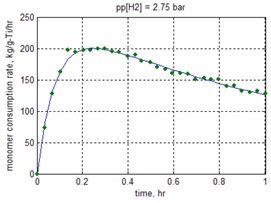Tutorial Question 1
Consider the Ziegler-Natta catalysed polymerisation of propylene in a batch reactor where the feed flow of propylene is controlled to maintain the concentration at a constant value of 20 mol.m-3.
The resulting rate data is presented in the figure below.

Tutorial Q 1: Estimate the kinetic rate constants for the data in the figure above.
Data: propagation rate constant kp = 3.4 x 10-2 mol.s-1.mol-Ti3+-1
Total sites concentration nTi = 0.3 mol-Ti.g-cat-1
a) Calculate any site transformation parameters that can be calculated from this data.
b) How does the method change if this were ethylene?
Tutorial Question 2
The Ziegler-Natta catalyst is an agglomeration of catalyst microfragments (microparticles). Mass transfer resistance may occur on two levels; first, in the void spaces between the microparticles and second through the polymer layer itself. When interpreting kinetic data such as that presented in Question 1, estimating constants is complicated by this transfer resistance.
In a second experiment, an attempt is made to determine the actual reaction monomer concentration by preventing agglomeration through chemical and physical processing of the catalyst particles. It is understood then that the monomer concentration at the catalyst site will change with time.
a) Develop a relationship to determine the monomer reaction concentration as a function of time.
b) Now predict the particle reaction rate for the case of microfragments agglomerated as particles and where the mass transfer resistance through the polymer is negligible.
Data
Catalyst bed density ρcat = 600 kg.m-3
Average size of microfragments rs = 2μ(i.e. 2 microns)
constant kp = 3.4x10-2mol.s-1.mol-Ti3+-1
Total sites concentration nTi = 0.3 mol-Ti.g-cat-1
Equilibrium constant for propylene in polymer η* = 0.45
Tutorial Question 3
The Ziegler-Natta catalyst provided by a certain catalyst manufacturer is porous to the extent that external mass transfer is negligible. In addition, catalyst additives ensure that the polymer produced also offers negligible mass transfer resistance.
For this catalyst, there is a requirement that the overall polymer growth factor (i.e. mass polymer produced per mass of catalyst) is 200.
What would the required mean residence time in the reactor be?
What would the production rate be?